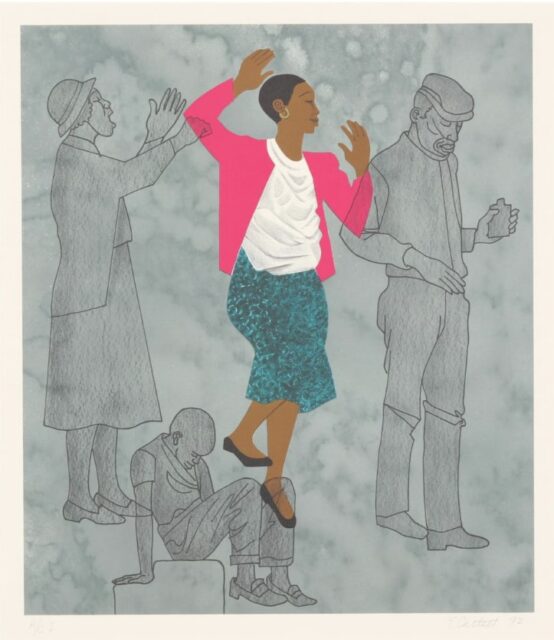Elizabeth Catlett (American, 1915-2012)
Walking Blindly, 1992
Lithograph
15.75 x 13.5 in.
Gallery Purchase
Walking Blindly by Elizabeth Catlett features four figures: one, in the center, immediately catches the eye with her vibrant color, from the bright pink of her jacket and wrinkled white of her shirt to the aqua blue of her textured skirt. Her hands reach up above her face, as if to protect herself. Around her, three other figures appear in a transparent shade of gray. One grayscale figure appears to be a woman shouting, her hands raised in front of her. Below her is a boy on a step, hunched over and head hung down. Lastly, an older man stands solemnly, holding what appears to be a flask in one hand. The woman in full color overlaps the gray figures, though it is not clear which figures lay below being seen or rest on top being seen-through.
Each figure has their eyes closed, blinding themselves as the title suggests. The woman in vibrant color appears to be walking past the other figures, but because of her blindness, walks into, or perhaps right through, each of them. With a slight smile on her face, the woman in color sidesteps the protesting woman, the sorrowful boy, and the saddened man. Her hands are raised; she does not seem to care. She keeps walking in her mimed bubble, eyes closed and face content, missing the struggles that surround her.
Artist Elizabeth Catlett, widely known for her sculptures and other work reflecting on social justice and the Black experience in 20th century America, created this print in response to Margaret Walker’s poem, For My People. This famous poem, written 57 years prior to the print’s creation, seeks to acknowledge the struggles and victories of African Americans, serving as a call to action to unify against the strife and the oppressors of the past and present. Walking Blindly specifically depicts the seventh stanza of Walker’s poem, which reads:
“For my people walking blindly spreading joy, losing time
being lazy, sleeping when hungry, shouting when
burdened, drinking when hopeless, tied, and shackled
and tangled among ourselves by the unseen creatures
who tower over us omnisciently and laugh.”
From this, we can identify the gray woman as the one “shouting when burdened,” the young boy as “sleeping when hungry,” and the older man as “drinking when hopeless.” The woman in color appears to be the figure who is “walking blindly.” The overlapping of figures may allude to the line of “tangled among ourselves.”
At first glance, I assumed the woman was ignoring the people around in her an attempt to erase them. The other figures blend into the background, and her vibrancy of color and slight smile could suggest a dominance against the rest and a blindness she creates purposefully. However, after reflecting on the poem, I wonder if this blindness does not indicate an intentional stomping on others. Instead, perhaps the ignorance of the woman in color serves as coping mechanism, the only way for her to process and escape from the suffering of her environment. Or, maybe her ignorance is her own form of resistance. She refuses to be subjected by anyone and continues to walk forth in full color, forging her own path. Maybe she is not truly ignorant, but simply “walking blindly spreading joy,” creating her own happiness when others have tried to take it away from her. Unlike the figures in gray, perhaps she has found her own way to throw her hands up against the “unseen creatures who tower over us omnisciently and laugh.”
Only viewers have the ability to notice any of the figures in the piece; none of them can see each other. I wonder how the piece would change if the central woman could open her eyes. If she could see those around her, would she lose her color? Would she start shouting, or hang her head in desperation? Would she keep walking right through everyone, even if she could see them? Is she indeed “losing time being lazy,” or is her blindness the only thing allowing her survival?
Whether or not the central figure holds blissful ignorance or intentional inattention, Catlett’s work poignantly reflects the ideas of Walker’s poem and the experience of African Americans who have fought and continue to fight against the racism and injustice that plagues the nation. Still, as I observe this piece and reflect on the colors, positions, and expressions of each figure, I cannot help but return to the basic question: why is everyone blind?
– Gaby Sanclimenti ’25
Walker, Margaret. “For My People by Margaret Walker.” Poetry Foundation, https://www.poetryfoundation.org/poetrymagazine/poems/21850/for-my-people.

